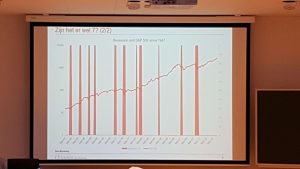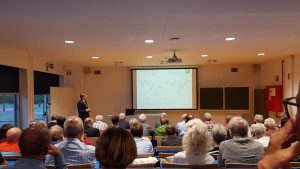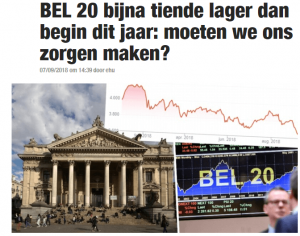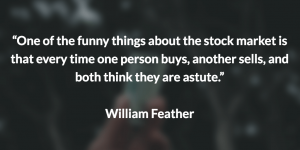The summer vacation has ended for the kids and the VFB investors organization also kicks off his year end program. In July I had marked the date 3rd of September in my calendar. A presentation of the economist Bruno Verstraete caught my interest. There is a strong correlation between the economy and the stock market. That’s why economists forecast sector trends and rotations in the markets.
So Monday 3rd of September I headed to the location of this presentation. Read below our summary.
Who is Bruno Verstraete ?
 Mr. Verstraete is a private banker and recognized early in his career that high net-worth clients only trust an independent, qualified professional, who protects their wealth and keeps an overview of their total portfolio. At Lakefield his macro-economic view is a challenging factor at the investment committee meetings. His opinion is shared on frequent appearances at CNBC and the local press. Mr. Verstraete has been an independent asset manager since 2003.
Mr. Verstraete is a private banker and recognized early in his career that high net-worth clients only trust an independent, qualified professional, who protects their wealth and keeps an overview of their total portfolio. At Lakefield his macro-economic view is a challenging factor at the investment committee meetings. His opinion is shared on frequent appearances at CNBC and the local press. Mr. Verstraete has been an independent asset manager since 2003.
Mr. Verstraete is the Belgian partner en chief economist within Lakefield Partners Asset Management Zürich, Switzerland. Lakefield Partners is specialized in ‘asset allocation’ financial advice. This means that they invest in different asset sectors and decide when and how much. Portfolios are monthly re-evaluated and adjusted according to new economical circumstances. The core strategy allows to invest between 0% and 100% in stocks. The alternative is bonds or cash. The company has created ETFs in Luxembourg which contain stocks from worldwide sectors and/or regions.
Summary of the Presentation “Seven Fat or Seven Skinny Years ?”
The title sounds like taken from the bible. Goal of the presentation is to give you a long term perspective and how to anticipate from a short term perspective.
Bruno starts with a presentation of his company Lakefield Wealth Management, a company who has created 10 ETF funds. Their customers can choose between 0-100% stocks allocation. Customers are institutional investors and wealthy retail investors. The Multi-Asset Strategy has a return of +6,45%. Dynamic World Strategy is YTD 12,49%.
The presentation consists of 6 bullet points.
- The magical 7
How many crashes did the stock market have ? 5,9 years i s the average time fence when each stock market occurs. The stock market restores within the 3 years. A bull market dies because of a recession on the horizon. The key is to predict the recession and the following crash of the stock market.
s the average time fence when each stock market occurs. The stock market restores within the 3 years. A bull market dies because of a recession on the horizon. The key is to predict the recession and the following crash of the stock market.
Crashes go much quicker. In Belgium a lot of money is parked on savings accounts and then money is invested in the wrong moment. People don’t know when to invest in the stock market correctly.
When does a recession occur ? Bart reiterates that 5,9 years is the timing of each occurring recession. The stock market goes down before the recession hits.
- The twitter fever
There is a lot doom thinking. There is a lot of pessimism in the market. One reason is the attitude of the press and media. They love Trumps tweets. This leads to volatility.
The question is whether this is uncertain times….take a look at the graph. Despite many geopolitical events, the stock market did hardly react. Overall capital grew 5,35 times during this period. The economy did very well on the contrary.
What is most important? What are the quarterly earnings of a company ? No, this is not so important. All companies stock prices will go down during a recession. During years 50 and 60’s, the stock market reacts before the recession hits. You need to understand in which stage of the economy we are..
- The economic cycle
An investor needs to follow the economic cycle. What are the key indicators to predict a recession in an economic cycle? The flow is CRISIS, RECOVERY, EXPANSION (GROWTH above long term trend), GOLDILOCKS (stable growth, growing inflation, stable profits, normalized financial conditions), OVERHEATING
So where are we now ? And is this in all regions the case ? In below slide you can see the situation for the different countries and/or regions.

- Indicators
- Macroeconomic indicators
Global economic growth is around 3,1%. This is a slow process. Inflation has not grown drastically. Central banks have put 2% as an objective for the inflation. There is no hyperinflation. Inflation growth occurs normally when commodities become more expensive. This is not the case today. Today the prices of commodities is going down due to less demand in China.

Overcapacity is another reason for inflation growth. Today there is 78% utilization in US. In Europe the production capacity utilization is higher. This is very visible in the oil sector. Jobless quota % is another factor. Higher salaries lead to higher cost prices of products. In Europe unemployment is the lowest since 1990.
In some sectors there are big problems to find qualitative people, although there is a slack of people who don’t want to work.
What is the US Financial Conditions Index ? Banks are an important element within the economy. Banks use leverage of 1:10 to put the money at work with loans. Today the US index is healthy. The EU banks situation is totally different and not so positive. Printing money from the central banks is the biggest bubble. Fed owns 17% of government debt. This is long term interest rate manipulation.
And now Trump starts financial stimuli, tariffs, big infrastructure works…completely insane for the economy. US Fed is slowly cleaning up his balance sheet. Europe cannot do this at the moment. US Dollar should logically increase strongly compared to the euro.
- Company indicators
Large Caps Global Company indicators…. Profit margins could decrease. Profit is 25% increased in US, in Europe only 5%. That’s why EU stock markets have been lagging behind. Is the glass half full or half empty? In US all indicators are still green. In Europe there is no progress. That is the simple conclusion.
- Where are we today?
We are today in the second half of the economic cycle. This cycle is long and slow. She can be made longer by political measures (fiscal stimuli) or investments. This should not scare us, but alerts us to follow up closely economic indicators. The global economy is stable but less synchrone than 1 year ago. Inflation is under control but not really a problem. The USA will be the first to see the recession on the horizon.
What are the risks ? Political mistakes… more volatility to the currencies. Bonds are a clear risk ! Government debt is a major problem ! This can not be solved going forward. If the government can not finance itself because we don’t buy anymore bonds…there is a major issue. The big debt issue does not have a lot of solutions.
- How do we act as an investor?
Bruno lists out 9 tips how to deal with those risks going forward as an investor.
The tips are :
- Be systematic and disciplined (exclude any emotions !)
- Think Short term and long term : Where will the $ currency price over 1 year compared to 1 month ?
- Passive – Active : ETFs are good if you manage them properly. There are not so cheap tough. Bankers and MIFID are to blame for categorizing you in ONE BOX. Are you a balanced investor ?
- Think about correlations in the portfolio.
- Global thinking : Don’t invest only in your own country. Lakefield Partners is not invested in Belgian stock market.
- Think in terms of region, sector, think profile (defensive/cyclic)
- If you know the risks and have it under control, do it and dare
- Dare to think in worst cases if the possibility can occur : what can be the impact if the EURO currency would collapse ?
- Avoid losses, even if they feel good. Don’t fall in love with a brand or a company even if you know the company very well….
If you have 25 stocks, you can be perfectly diversified. The methodology of Lakefield Partners is very simple: Focus on expected return, then evaluate the expected risks and what is your risk aversion.
Today the portfolios are mainly invested in technology in US. The asset allocation is 58% Equities with 25% in Global Technology, 10% in North American stocks and 8,8% invested in Japan. The Fixed Income allocation is 33,7%. There is more cash buildup and avoidance of bonds. Be aware that the best stock market days are coming after the worst days. Buy when everyone walks away. If the economy recovers, you can step in again. 7-8% of Belgians have a savings account of 100k or more and they are losing money every month as their net worth loses value over time.
The evening ends with a Questions and Answers from different investors.
Final Note

What did we learn ? The two most interesting parts of this presentation are the description of the economic cycle for the different regions and how a private banker is invested within different asset classes. From previous research during VFB events, we know that the Belgian investor is mainly a buy and hold investor in companies that he knows and does research on. I agree that the USA will be the first to see the recession on the horizon. With each new tariff addition from President Trump, another risk is added to the stock market. President Trump hopes that production will shift from China to the USA by increasing more tariffs on China trade and other countries.
What he doesn’t seem to realize that products will become more expensive locally and people will stop buying goods. When demand for products will drop, the recession will kick in hard on the economy. In Europe the stock market has been lagging behind and the economy is not so flexible as in the USA. A Belgian newspaper highlighted that the Belgian stock market is today 9% lower compared to 1st January 2018. Scare the retail investor is what the media is good in…. did we read any article about the longest bull market ? Personally I am not invested in the Belgian stock market. I agree with Bruno that as an investor you need to follow the strongest economies and the strongest sectors such as technology (highlighted to you many times in my Sector Watch blog posts) and healthcare. Global thinking and risk management is key. Don’t be afraid to be in cash when needed.
It was interesting for us to attend this presentation. We hope you learned something from this blogpost and you appreciate our effort to write up the summary.
Don’t hesitate to leave your comments and feedback. Let us know what you think.
Good luck with your personal finance strategy! Thanks for following us on Twitter and Facebook and reading this blog post. As always we end with a quote.


No Comment
You can post first response comment.